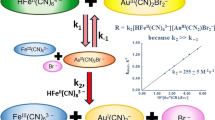Abstract
The Gibbs free energies of formation of strontium and barium zirconates have been determined in the temperature range 960 to 1210 K using electrochemical cells incorporating the respective alkaline-earth fluoride single crystals as solid electrolytes. Pure strontium and barium monoxides were used in the reference electrodes. During measurements on barium zirconate, the oxygen partial pressure in the gas phase over the electrodes was maintained at a low value of 18.7 Pa to minimize the solubility of barium peroxide in the monoxide phase. Strontium zirconate was found to undergo a phase transition from orthorhombic perovskite (o) with space groupCmcm; D 172h to tetragonal perovskite (t) having the space group 14/mcm;D 184h at 1123 (/+- 10) K. Barium zirconate does not appear to undergo a phase transition in the temperature range of measurement. It has the cubic perovskite (c) structure. The standard free energies of formation of the zirconates from their component binary oxidesAO (A = Sr, Ba) with rock salt (rs) and ZrO2 with monoclinic (m) structures can be expressed by the following relations: SrO (rs) + ZrO2 (m) → SrZrO3 (o) ΔG° = -74,880 - 14.2T (/+-200) J mol-1 SrO (rs) + ZrO2 (m) → SrZrO3 (t) ΔG° = -73,645 - 15.37T (/+-200) J mol-1 BaO (rs) + ZrO2 (m) → BaZrO4 (c) ΔG° = -127,760-1.79T (/+-250) J mol-1 The results of this study are in reasonable agreement with calorimetric measurements reported in the literature. Systematic trends in the stability of alkaline-earth zirconates having the stoichiometry AZrO3 are discussed.
Similar content being viewed by others
References
D. Janke:Metall. Trans. B, 1982, vol. 13B, pp. 227–35.
K.T. Jacob and Y. Waseda:Thermochim. Acta, 1994, vol. 239, pp. 233–41.
E.H.P. Cordfunke and R.J.M. Konings:J. Nucl. Mater., 1988, vol. 152, pp. 301–09.
E.H.P. Cordfunke and R.J.M. Konings:Thermochemical Data for Reactor Materials and Fission Products, North-Holland, Amsterdam, 1990.
E.G. King and W.W. Weller: U.S. Bureau of Mines Rep. Invest. 5571, Department of the Interior, Washington, DC, 1960.
V.A. Levitskii, D.Sh. Tsagareishvili, and G.G. Gvelesiani:Teplofiz. Vys. Temp., 1976, vol. 14, pp. 78–84.
K. Nagarajan, R. Saha, R. Babu, and C.K. Mathews:Thermochim. Acta, 1985, vol. 90, pp. 297–304.
E.N. Fomichev, N.P. Slyusar, A.D. Krivorotenko, and V.Ya. Tolstaya:Ogneupory, 1973, vol. 7, pp. 36–39.
E.H.P. Cordfunke and R.J.M. Konings:Thermochim. Acta, 1989, vol. 156, pp. 45–51.
A.S. L’vova and N.N. Fedos’ev:Russ. J. Phys. Chem., 1964, vol. 38, p. 14.
E.T. Muromachi and A. Navrotsky:J. Solid State Chem., 1988, vol. 72, pp. 244–56.
V.A. Levitskii:J. Solid State Chem., 1978, vol. 25, pp. 9–22.
L.B. Pankratz:Thermodynamic Properties of Elements and Oxides, U.S. Bureau of Mines Bull. 672, Department of the Interior, Washington, DC, 1982.
L.B. Pankratz:Thermodynamic Properties of Halides, U.S. Bureau of Mines Bull. 674, Department of the Interior, Washington, DC, 1984.
V.A. Levitskii, Yu. Ya. Skolis, Yu. Kheminov, and N.N. Shevchenko:Russ. J. Phys. Chem., 1974, vol. 48, pp. 24–27.
O.V. Kedrovskii, I.V. Kovtunenko, E.V. Kiseleva, and A.A. Bundel:Russ. J. Phys. Chem., 1967, vol. 41, pp. 205–08.
R. Akila, K.T. Jacob, and A.K. Shukla:Bull. Mater. Sci., 1986, vol. 8, pp. 453–65.
M.D. Mathews, E.B. Mirza, and A.C. Momin:J. Mater. Sci. Lett., 1991, vol. 10, pp. 305–06.
K.T. Jacob and J.P. Hajra:Bull. Mater. Sci., 1987, vol. 9, pp. 37–46.
K.T. Jacob, K.P. Abraham, and S. Ramachandran:Metall. Trans. B, 1990, vol. 21B, pp. 521–27.
A. Ahtee, M. Ahtee, A.M. Glazer, and A.W. Hewat:Acta Crystallogr., 1978, vol. B32, pp. 3243–46.
M. Ahtee, A.M. Glazer, and A.W. Hewat:Acta Crystallogr., 1978, vol. B34, pp. 752–58.
Author information
Authors and Affiliations
Rights and permissions
About this article
Cite this article
Jacob, K.T., Waseda, Y. Potentiometric determination of the gibbs energies of formation of SrZrO3 and BaZrO3 . Metall Mater Trans B 26, 775–781 (1995). https://doi.org/10.1007/BF02651723
Received:
Issue Date:
DOI: https://doi.org/10.1007/BF02651723




